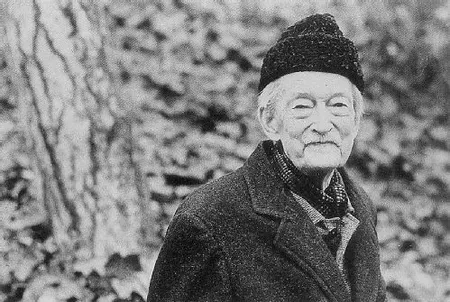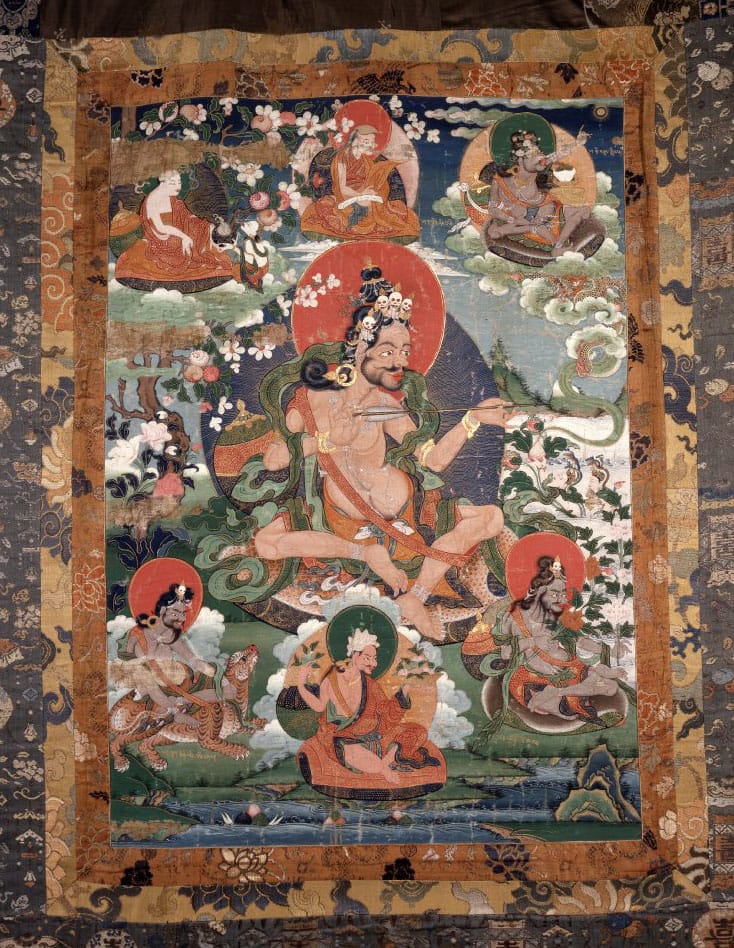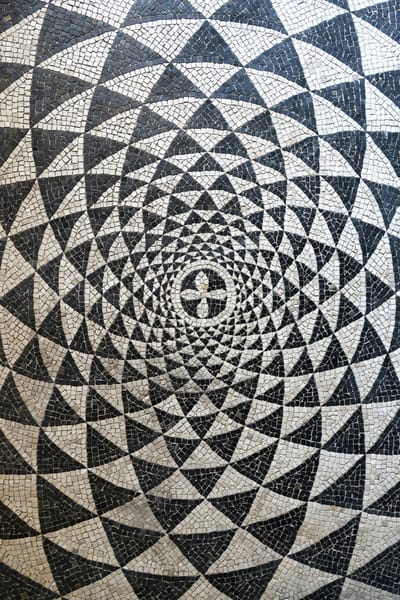The saint is effectively the void made for the passage of God.
(Frithjof Schuon)
He who clings to the void and neglects Compassion
Does not reach the highest stage.
But he who practices only Compassion
Does not gain release from the toils of existence.
He, however, who is strong in practice of both,
Remains neither in Samsara nor in Nirvana.
(Saraha)
It is a curious fact of modern lives, particularly in urban societies, that people are increasingly hard-edged and jaded, burying their vulnerabilities deep within an exterior of toughness and resignation. Their detachment renders them capable of gazing vacantly at images of violence and depravity or of shrugging indifferently at news of war, famine or disaster. For them, in the words of Tennessee Williams, “happiness is insensitivity”. This insensitivity—the detachment of modernity—is very different to the quality of detachment advocated by Tradition as a virtue. It is not a detachment of compassion and serenity, rather a paradoxical amalgam of unconcern and craving.
The detachment of Tradition, by contrast, is grounded in compassion, not in insensitivity. The basis for this detachment is a view of reality as both transcendent (hence the distance of detachment) and immanent (hence the intimacy of compassion). The acceptance of transcendence necessarily imparts the recognition of our own indigence and contingency in relation to the Absolute, producing a sense of wonder and humility that is all but lacking in the modernist outlook. At the same time, the acceptance of immanence imparts an awareness of the integrity of reality, producing a sense of its sacred interrelatedness and an abiding compassion for all things that is the very antithesis of insensitivity.
the denial of transcendence is a defining feature of modernism, the ethos of modernity
It is, from the Traditional point of view, fundamentally erroneous to lose sight of our essential connectedness or to attempt to locate it outside transcendence and the integrity of reality. This is a principal error of modernism and a feature of modernity. By this, it is not suggested that to live in the contemporary world is necessarily to deny transcendence—merely that the denial of transcendence is a defining feature of modernism, the ethos of modernity—an ethos that has been characterized by contemporary commentators variously as narcissistic and apathetic. This denial, where it exists, lies at the root of modern humanity’s conflation of compassion and passion, of joy and pleasure, of depth and intensity. and it is the cause of its tendency to reduce virtue to empty forms and gestures, and to favor subjective expressions of privatized morality or self-indulgent excesses of sentimentalism.
It is only by witnessing the spiritual basis of all life—the vision of creation as a theophany—that humanity can discover the criterion for the love of itself...
It is not difficult to understand how the denial of transcendence can lead to the postmodern excesses of relativism, subjectivism and, ultimately, nihilism. However, a more insidious threat to humanity lies in the modern inversion of transcendence—through abstraction, that is, the reduction of spirituality to its merely mental or psychic aspects, creating thereby a false detachment from the full spectrum of theophanic reality. Disconnected thus from its spiritual center, the soul’s innate passion finds no opening into compassion, seeking in vain for its complement, becoming increasingly listless, and, though seeking outer pleasures, is unable to find the inner wellsprings of joy.
It is interesting to note that the Hesychasts used the original Greek word apatheia, not to mean what we now call “apathy”, but to mean “detachment” in the traditional sense of an absence of egoism and distorting passion—that is, dispassion and the purity of the heart. This is the “void made for the passage of God”. It is only in such virgin soil that the flower of compassion—of love that is not self-contained but out-pouring and engaged—can grow. Contrast the disengaged “love” of abstraction. It was the statement of a clearly modernist sensibility that uttered Ivan Karamazov’s celebrated commentary on one of Jesus’ central teachings: “The idea of loving one’s neighbour is possible only as an abstraction: it may be conceivable to love one’s fellow man at a distance, but it is almost never possible to love him at close quarters.“ How easy it is to love in the abstract! and how much more demanding it is to actualize the needs of love in the concrete context of our relationships and the exigencies of daily living! It is helpful to remember that in Christianity, the commandment to “love thy neighbor as thyself” is subordinate to “the first and great commandment” to “love the Lord thy God with all thy heart, and with all thy soul, and with all thy mind” [Mt. 22:37].
According to traditional metaphysics, it is principle that informs process. It is the principial relationship of man and God on the vertical plane that gives meaning to all creaturely relationships on the horizontal plane. Humanity’s love for the creatures of God is therefore grounded in the transcendental affirmation of humanity’s love of God. This is not an abstract love, but a love that is animated, imbued with the presence of life. It is only by witnessing the spiritual basis of all life—the vision of creation as a theophany—that humanity can discover the criterion for the love of itself: not the narcissistic love that feeds on itself, but the selfless love that is fed by what it gives of itself. This is the criterion of loving the neighbor as oneself.
It is only through the experience of spiritual intimacy that one can be initiated into the mysteries of existence.
It is helpful to recall that, based on its etymology and in its traditional usage, the word “theoretical” (derived from the Greek theoria, suggesting “vision”) does not signify an abstraction, as its modern usage implies, but rather imparts the sense of “presence” or an “envisioning” of reality. This is one of the reasons why traditional sages are often referred to as “seers”. What distinguishes their perception from that of the common man is precisely their ability to “see” by looking beyond the veil of metaphysical transparency—thereby to perceive the transcendent dimension and its pervasive manifestation in all things. It is only through the experience of spiritual intimacy, seeing the other as present, that one can be initiated into the mysteries of existence.
This is why, in vedantic terms, ayam atma brahma (“The Atman is the Brahman”)—in other words, immanence is, paradoxically, an aspect of transcendence. It is interesting to note how the modern usage of the word “theoretical” suggests a distancing—through abstraction—of “reality”, hence of God (or supra-formal, spiritual reality) and, a fortiori, of the “Self” (the divine or spiritual imprint within each human being), devaluing these terms and reducing them to their peripheral meanings.

Evidence of such a reduction is also apparent by contrasting the different outlooks of the traditional and modernist worlds regarding the term “humanism”. Following Jacques Maritain, one can distinguish between two forms of humanism: the traditional (l’humanisme intégrale), which is premised on spiritual reality (or God) as the center of human existence, and the modernist, which views human beings as their own center and the center of all things.
Traditional humanism, then, is a form of spiritual courtesy which connotes more than merely social or religious convention. In Islam, for example, the Arabic term for “humanism”, adab, usually translated as “courtesy,” signifies the manifestation of ihsan, that is to say, intrinsic beauty, projected in the sincere virtuous conduct (spiritual courtesy) of the individual, or in a culture and ethos of spiritual (theocentric) humanism. It is an attitude of attention to the inner qualities which exist within all human beings as marks of their spiritual origin. It is also a sensitivity to the divine image within each of us and a specific awareness of that spiritual Presence residing within each individual, no matter how faint or weak.
By contrast, for modernist (or anthropocentric) humanism, the impoverished view of reality, lacking the vision of spiritual Presence, responds obliquely to the human soul’s authentic need for order by producing merely the counterfeit of adab in the forms of societal norms of civility, privatized morality, and procedurally-regulated “values” or codes of behaviour. These behavioural approximations of order and courtesy, being disconnected from their spiritual Center, are not the transforming “virtue” of Tradition “which wounds our nature as the plough wounds the soil” (Schuon), but represent merely a necessary—and sometimes conscienceless—pragmatism.
The distancing or abstraction that marks the detachment (a better term might be disconnectedness or apathy) of modernity is none other than our ontological distance from our spiritual Source—and therefore, in traditional metaphysics, also from our own humanity and rightful place in the cosmos. It is this ontological distance that religion seeks to bridge, reconnecting us to our Center and origin—as is evident from the etymology of the term “religion” (derived from the Latin root, ligare, signifying a binding).
True adab, on the part of human beings, is foremost a matter of orientation. In traditional societies, human beings are oriented—both in intellect and will—towards the Source of Illumination, that is to say, theocentrically, towards the Supernal Sun. It is helpful to note that the Orient (from which the term “orientation” is derived) is the source of the physical light of the Sun—a felicitous metaphor for the discerning Intellect. Just as the sun illumines us, it enlivens us also. It is only by correctly orienting ourselves that we can begin to efface the darkness of our ignorance and to overcome our apathy and lassitude by reconnecting with the Light that radiates in all beings. In the words of Niffarī: “You will not come out from your veil except through my Light.”
The detachment of Tradition, then, is the voiding of all that is merely human in order to merit the grace of reconnecting with our spiritual Center—by entering into the Reality of the Light that transcends all metaphor. It is this Light of compassionate serenity that constitutes the core of our very being, radiating within us as true adab, the genuine spiritual courtesy that reconnects us to our Maker and thence to our fellow-creatures, and the foundation within humankind of its integral humanity.



